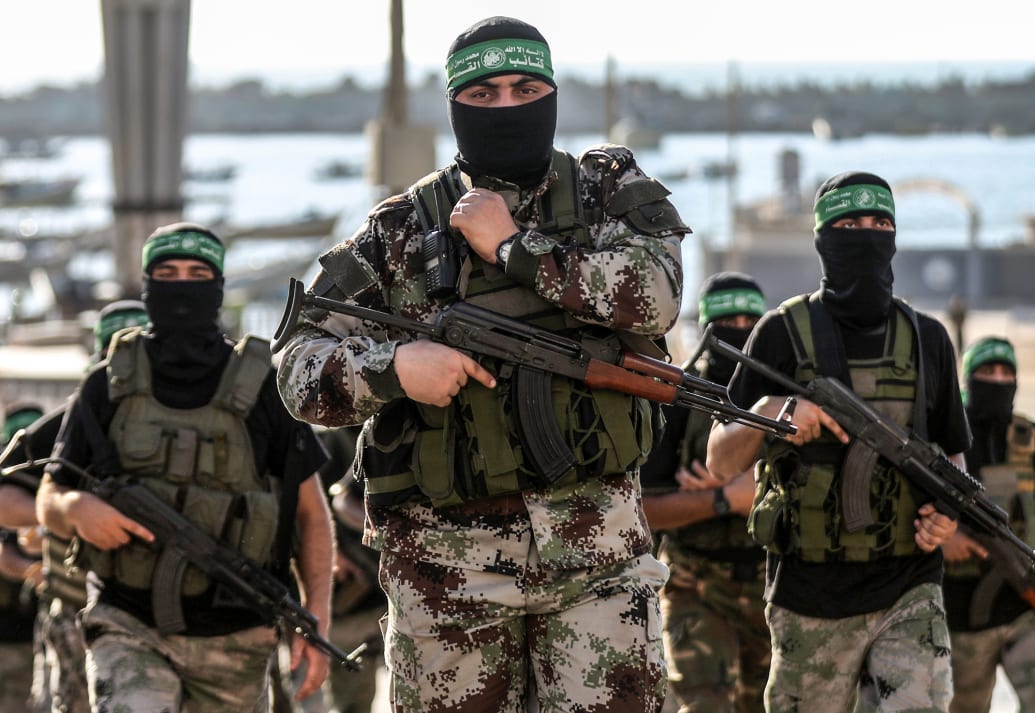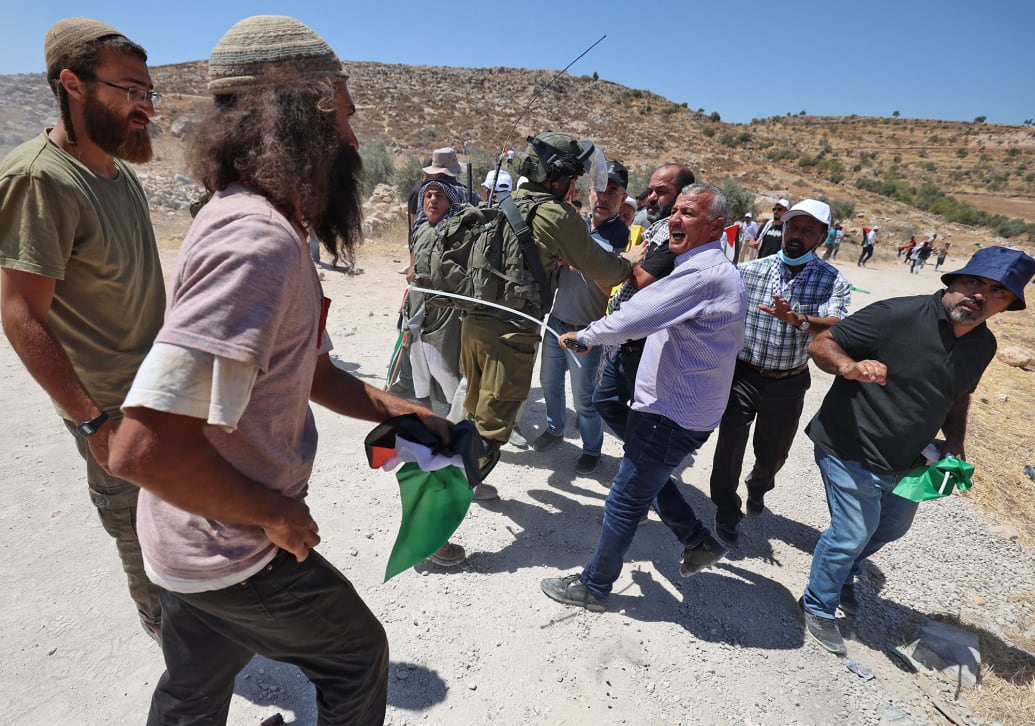Israel-Palestine was not a good situation prior to the Oct. 7 attack and subsequent Gaza war. It’s been bad for decades, and worse since Hamas forcibly took power in Gaza in 2007.
The status quo before the current war had Gaza under Israeli-Egyptian blockade, and Hamas authoritarian internal control, with occasional smaller wars between Israel and Hamas involving aerial exchanges that left hundreds, sometimes thousands dead (mostly Palestinians). West Bank settlements kept expanding, and Israel had the most far-right government in its history, including advocates of annexation and ethnic cleansing.
Israel and even some Gulf Arab states were acting as if the Palestinians could be squeezed and ignored, and the United States encouraged that approach for four years under then-President Donald Trump. It was a bad situation, getting progressively more entrenched.
The current violence, the deadliest this century by far, has upended that untenable situation.
A central goal of anyone who hopes for peace should be ensuring that the situation doesn’t return to the pre-war status quo, or a new version that would likely be worse.
Some obstacles that long appeared unmovable are wobbling. It won’t be easy, the odds are against it—but there’s a chance, higher in years, that they could be removed, opening a path for lasting peace. But if any of these five obstacles remains, it could thwart peace efforts on their own, and help other obstacles re-entrench.

Izz al-Din al-Qassam Brigades soldiers, the military wing of Hamas, during an anti-Israel military march in Gaza City, Palestine in July 2022.
Yousef Masoud/Majority World/Universal Images Group via Getty Images
1. HAMAS
Peace with Hamas is impossible, because they don’t want it. The group is dedicated to Israel’s destruction, and stands opposed to Palestinians who seek peaceful coexistence. If anyone thought that was bluster—for leverage, something to be negotiated away—Oct. 7 proved otherwise. Hamas aimed for an attack that was so big and so appalling that it would prompt a massive, brutal Israeli military response, which Hamas hoped would spark a regional war.
Even seeing the immense suffering they brought down upon the people of Gaza, and the absence (at least as of now) of a multi-front war that could lead to Israel’s military defeat, Hamas leaders have vowed to try again.
Hamas is an organization made up of human beings with agency. If permanent hostility is their choice—and as long as Israel exists, it apparently is—then a temporary ceasefire is possible, like those that ended previous Gaza wars (but didn’t hold for long). But peace is not.
That means the only possible solution involves force. Eliminating Hamas is Israel’s main military objective, one they’ve pursued with heavy ordnance and loose rules of engagement, resulting in well over 10,000 dead civilians and over a million displaced. In light of that mass suffering, international pressure to end major combat operations is growing, including from the United States, Europe, and the UN Security Council.
The idea of Hamas can’t be eliminated, but the group’s ability to act as an organized governing and military entity could, similar to how ISIS no longer controls a self-proclaimed “caliphate” in Syria and Iraq. But Israel might not be able to, in part because Hamas leaders dispersed and hid. And even if Israel manages to dislodge Hamas from control of Gaza, it raises challenging questions about what comes next. But whatever entity comes next may be interested in peace, while Hamas is not.
However, if the war ends and Hamas is still standing, with de facto recognition as the governing authority in Gaza, the most likely result will be an even tighter blockade. Anything else would mean making it easier for the group behind Oct. 7 to rearm, bigger and faster. Critics would denounce the blockade as unjust, but the national security logic is straightforward. Israel and Egypt have the power to do it, and probably will.
It’s possible that remnants of a weakened Hamas, without the most militant and ideological members, can be subsumed into a different entity governing Gaza. But if the organization retains power, negotiated peace won’t happen. Hamas insists peace with Israel is impossible, and Israel, especially after Oct. 7, thinks the same of Hamas.

An Israeli man walks past a billboard bearing portraits of Prime Minister Benjamin Netanyahu flanked by extreme right politicians Itamar Ben Gvir, Bezalel Smotrich and Michael Ben Ari, with a caption in Hebrew reading “Kahana Lives”—a reference to a banned ultranationalist party.
Thomas Coex/AFP via Getty Images
2. NETANYAHU AND HIS FAR-RIGHT COALITION
Peace with the Israeli government of Prime Minister Benjamin Netanyahu is impossible, because they don’t want it. Besides a brief period in 2021-22, Netanyahu has led Israel since 2009, during which Hamas controlled Gaza. Bibi seemed to like that, taking some steps to prop up Hamas because it kept the Palestinians in Gaza politically divided from those in the West Bank. The Israeli PM recently said it’s a point of personal pride that he “prevented the establishment of a Palestinian state.”
Israel’s 2022 election led to Netanyahu as prime minister with a narrow coalition that includes extremists, including the open supremacists of the “Jewish Power” party, which descends from a party that was banned for supporting terrorism. The government includes Heritage Minister Amichai Eliyah, who calls for full Israeli occupation of Gaza—including Jewish settlements—and National Security Minister Itamar Ben-Gvir, who glorified the 1995 assassination of peace-making Israeli leader Yitzhak Rabin. Agriculture Minister Avi Dichter, of Netanyahu’s Likud party, explained Israel’s military campaign as “rolling out the Gaza Nakba,” using Palestinians’ term for the violence and mass displacement they experienced with Israel’s founding.
With the war going on, Israeli leaders are adamantly rejecting a renewed push for the solution (supported by both the U.S. and UN) of creating an independent Palestinian state in Gaza and the West Bank.
Israel’s ambassador to the UK Tzipi Hotovely, when interviewed about the possibility, said “the answer is absolutely no.” A variety of top domestic officials, including Netanyahu and current “war cabinet” member Benny Gantz, reportedly asked the Biden administration to stop saying “two-state solution.”
Their openness to a one-state solution in which all Palestinians get full Israeli citizenship and the Jewish state is replaced by a pluralist one is even lower.
The good news is that removing the Netanyahu government is easier than removing Hamas: Israelis can vote them out. With Bibi’s egregious security failure on Oct. 7, Israelis appear ready to do so. But it probably won’t be quick. The latest date for new Israeli elections is Oct. 2026, and it’s unlikely Netanyahu’s coalition will dissolve or call for snap elections if they expect to lose.
The bad news is that a post-Netanyahu government may also oppose negotiated peace. Benny Gantz is the early favorite to replace him. And current opposition leader Yair Lapid, who briefly served as prime minister in 2022, is also among those reportedly asking the U.S. to cool it with two-state solution talk.

Palestinians mourn their relatives, killed in an overnight Israeli strike on the Al-Maghazi refugee camp.
Mahmud Hams/AFP via Getty Images
3. PALESTINIAN HOPELESSNESS
Hamas and Netanyahu’s coalition are governing entities that could be removed, but even if that happens, the more abstract obstacle of Palestinian hopelessness could undermine peace.
A common, cliched misconception is that war against terrorists just creates more terrorists, as civilians who suffer from the violence—who were close to people that became, in the sanitized military parlance, collateral damage—get angry and decide to join a terrorist group. That can be a factor with some individuals, but it’s hardly a guarantee.
ISIS hasn’t seen a rush of Iraqi and Syrian recruits since U.S.-backed Iraqis and Syrians defeated its caliphate in 2019. The Tamil Tigers haven’t returned despite a brutal Sri Lankan campaign that defeated the group in 2009.
The two factors the cliché misses are time and opportunity. Even under ideal circumstances, it takes time for terrorist groups to recruit new members. It takes time for new recruits to gain skills on par with more experienced terrorists that were killed, leaving the group weaker, at least temporarily. And it’s hard to recruit while terrorist leaders are hiding from a foreign military assault.
Hamas is currently popular among Palestinians, though that shouldn’t be considered permanent, since it’s typical for people under fire to rally to anyone fighting back, and that effect often dissipates after combat stops: 67 percent of Gazans “had little to no trust in Hamas” before this war, according to an Arab Barometer survey conducted shortly before the Oct. 7 attacks.
Some Palestinians angry at Israel’s bombing won’t conclude that a perpetual state of hostility is the right approach, and even some who do won’t join Hamas. But the possibility some get more militant and join a terrorist organization, or provide a social support structure for those who do, is real.
The key to counteracting that is creating realistic hope for the future. If things go back to the pre-war status quo of Palestinians divided and squeezed, or worse, many will conclude that there’s no hope—and at least violence exacts a measure of revenge.
That makes a big push for Palestinian rights, perhaps with an independent state, not only moral, but strategic as well.
At minimum, displaced Gazans must be allowed to return to their homes, and see a lot of international money to rebuild (from the U.S., oil-rich Arab states, Europe, and more). Israel must not attempt a sustained occupation of the territory, and definitely not start taking any of the land for Israelis. International and Palestinian forces will have to administer Gaza, at least for a time. Palestinian Authority president Mahmoud Abbas—88 years old, was scheduled to leave office in 2009 but never did, currently opposed by nearly 90 percent of Palestinians—probably has to go, too.
One thing that could help accomplish this difficult task is scheduling new Palestinian elections, with Hamas not allowed to run. It would have to be far enough in the future for new Palestinian parties to form, and to create the circumstances where taking a real shot at negotiated peace is effectively competing with perpetual conflict, but not so far that Palestinians see it as a distant “maybe.”

Israeli settlers fight with Palestinian protesters during a demonstration against settlement expansion in the village of al-Mughayer.
Abbas Momani/AFP via Getty Images
4. WEST BANK SETTLER MOVEMENT
One of the biggest sources of Palestinian hopelessness, which will have to be taken on to make peace possible, is Israeli settlers in the West Bank, and the government programs that support them.
West Bank Palestinians live in apartheid-like Bantustans, amidst nearly half a million Israeli settlers spread across a hundred communities, appropriating good land, and dividing the rest of the territory with exclusive roads and checkpoints. West Bank settlers have committed terrorism, and some are open supremacists, arguing that they have a religious claim to the land and advocating ethnic cleansing.
Even if Israelis remove Netanyahu and vote in a government opposed to settlements—a big if—countering the movement will be difficult.
When Israel unilaterally withdrew from Gaza in 2005, it evacuated about 8,000 people from 21 settlements, some of whom refused to go and needed to be removed by force. There are more than 50 times as many settlers in the West Bank, and while some that are right next to Israel proper can probably stay—two-state solution advocates envision land swaps as compensation—many deeper in the West Bank will need to be removed. And even Israelis critical of the settlers will be wary, since withdrawing from Gaza led to a hostile, Hamas-controlled enclave.
It will almost certainly require outside pressure. The United States has taken some small steps in this direction, recently banning violent settlers from getting U.S. visas, but real change will take large ones. If Israel continues to thumb its nose at American and international demands to, at minimum, stop supporting settlement expansion, the U.S. should threaten to cut military aid to Israel, and if necessary, follow through.
5. REGIONAL POWER COMPETITIONS
Cutting military aid to Israel, however, is unlikely because the U.S. and many other governments view the situation through the lens of international power.
The Middle East is broadly divided between the self-styled “Axis of Resistance” of Iran, Iraqi and Syrian Shia militias, the Houthis in Yemen, the Syrian government of Bashar al Assad, Hezbollah in Lebanon, and Hamas, arrayed against a loose coalition of the U.S., Israel, and Sunni Arab states (Saudi Arabia, Egypt, Jordan, UAE, Bahrain).
That’s a big part of why Gulf Arab governments have been relatively quiet about the Gaza war, and why the United States partners with the Israeli military (and the militaries of Egypt, Saudi Arabia, etc.) even while opposing some of its actions. Russia’s military intervention in Syria to help Assad, and Iran supplying drones for Russia’s war in Ukraine, add a global dimension.
Disrupting the possibility of Israel-Saudi diplomatic normalization was allegedly one of Hamas’ reasons for the Oct. 7 attacks. Since that normalization goes against the Axis of Resistance’s interests, Iran and its allies will likely work to prevent it, perhaps with force.
Meanwhile, the United States will probably keep prioritizing opposition to Iran over domestic issues anywhere in the Middle East, Israel-Palestine included. But concrete improvements for Palestinians could serve that regional interest by reducing the appeal of partnering with Iran and Hezbollah.
These five (and other) obstacles perpetuate each other, and if they remain in place, peace may be impossible, no matter how much advocates want it. The end of the current war will probably be the best opportunity in a generation for real progress in Israel-Palestine, and still really hard.

